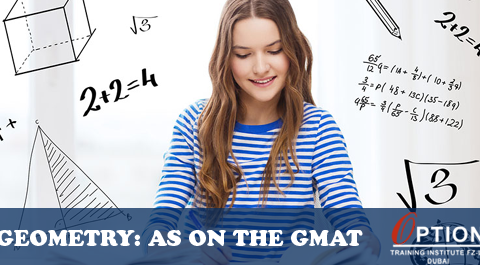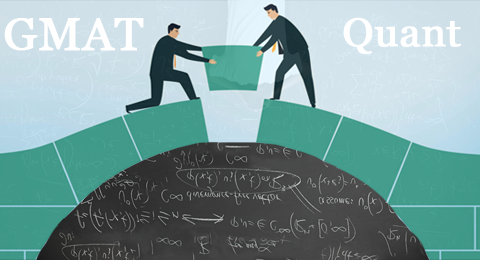- For Enquiry -
- +971 509267126
- +971 551207626
- enquiry@optioneducation.ae
GMAT geometry is always very logical. Most of the time, GMAT gives you a figure and some information to solve that figure’s missing angles or sides. GMAT Geometry in Problem Solving differs from geometry in Data sufficiency type as in most of the questions in PS; the figure is always drawn to scale unless stated by the question.
The very first concept in Geometry is Lines and angles. There are only three properties to solve all lines and angles questions.
1. Intersecting lines/vertical angles
When two lines intersect, the angles created by these lines possess special qualities. The opposite angles are equal in measure. These opposite angles are also known as vertical angles. The sum of adjacent angles equals 180 degrees.
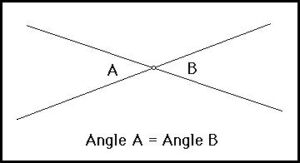
Angle A and Angle B are Vertical Angles.
- If two lines are not intersecting, the lines are parallel. Two intersections and vertical angles are created when two parallel lines are intersected by a third.
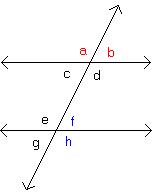
Angle a = Angle d = Angle e = Angle h
Angle g = Angle f = Angle c = Angle b
- Sum of Interior Angles = (n-2) × 180°
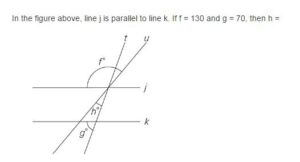
Each Angle (of a Regular Polygon) = (n-2) × 180° / n
Explanation:
If f = 130, then both large angles formed by lines t and k also measure 130°. Therefore, the small angles formed by those two lines measure 50° (notice that one of these angles is the left base angle of the triangle). If g = 70, then the angle above it (the other base angle of the triangle) must measure 110° to complete the 180° in a straight line. So far, you have 160° in the triangle. To complete the 180° total in the triangle, h must measure 20°.
The answer is choice (B).
Data Sufficiency Question:
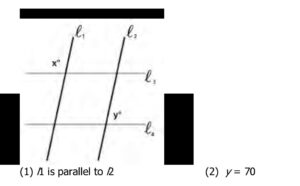
Explanation:
(1) INSUFFICIENT: We don’t know any angle measurements.
(2) INSUFFICIENT: We don’t know the relationship of x to y.
(1) AND (2) INSUFFICIENT: Because l1 is parallel to l2, we know the relationship of the four angles at the intersection of l2 and l3 (l3 is a transversal cutting two parallel lines) and the same four angles at the intersection of l1 and l3. We do not, however, know the relationship of y to those angles because we do not know if l3 is parallel to l4.
The correct answer is E.
Join our Classes for comprehensive and personalized guidance tailored to your academic goals. Classes for Digital Sat, ACT, AP, LNAT, UCAT.
- Filter by
- Categories
- Tags
- Authors
- Show all
- All
- ACT
- ACT Essay
- ACT Exam
- ACT Experts
- ACT Prep
- ACT Preparation
- ACT Test
- ACT Test Takers
- ACT Training
- ACT Writing Section
- Algebra
- AP
- AP AB
- AP BIOLOGY EXAM
- AP Calculus AB
- AP Course Prep
- AP Dubai
- AP Exam Test
- AP Test
- c-trap
- Chemistry Subject SAT
- Class Schedules
- Concepts
- COVID 19
- Digital SAT
- DIGITALSAT
- DSAT
- EVEN
- Factors
- GEOMETRY
- gmat
- GMAT MATH
- GMAT Prep
- GMAT Preparation
- gmat quant
- GMAT Scores
- GMAT Section
- gmat test
- GMAT VERBAL
- GMAT Verbal Section
- GRE
- GRE Prep
- GRE Test
- INSEAD
- Junior SAT
- LNAT
- Math
- mathematics
- MBA
- MBA Program
- Multiples
- New SAT
- NEW SAT ESSAY
- Number Properties
- NUMBERS
- Objectives of AP
- ODD
- Option
- QS Event
- Remainders
- SAT
- SAT Biology
- SAT BIOLOGY E/M
- SAT CANCELLATION
- SAT Chemistry Subject Test
- SAT Dubai
- SAT Essay
- SAT Exam
- SAT Grammer
- SAT II
- SAT Language Section
- SAT MATH
- SAT Prep
- SAT READING SECTION
- SAT Subject
- SAT Subject Test
- SAT Test
- SAT Test Takers
- SAT Trainers
- SAT Writing
- SAT Writing Section
- Skills
- Starting Classes
- Subject SAT
- Subject SAT Math Level 2
- Subject Test
- Test Prep
- Test Takers
- Training Institute
- Triangles

